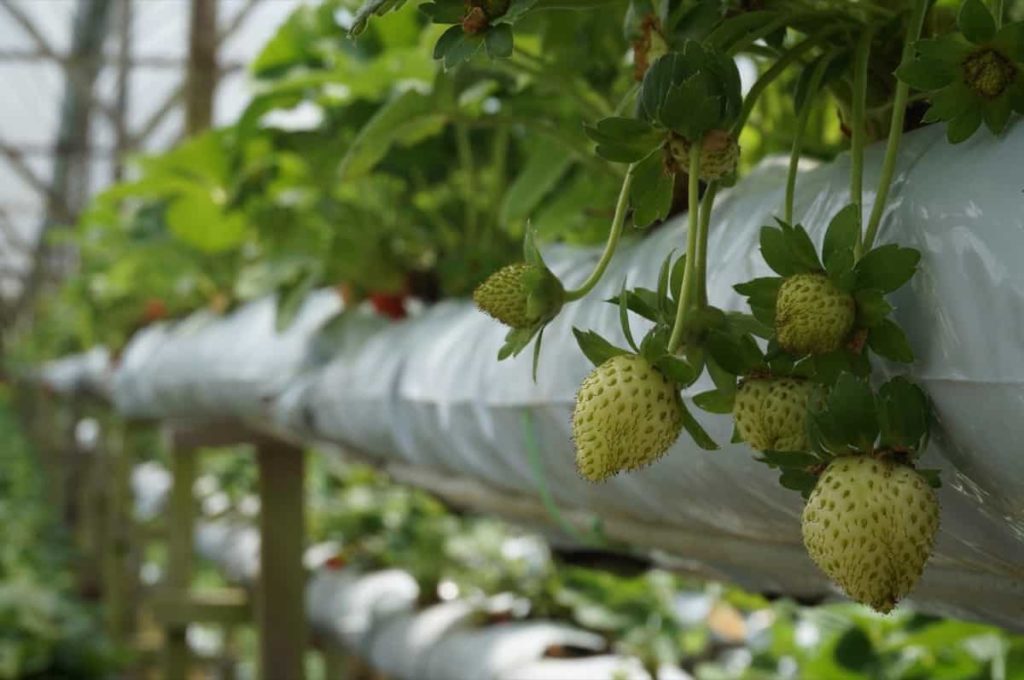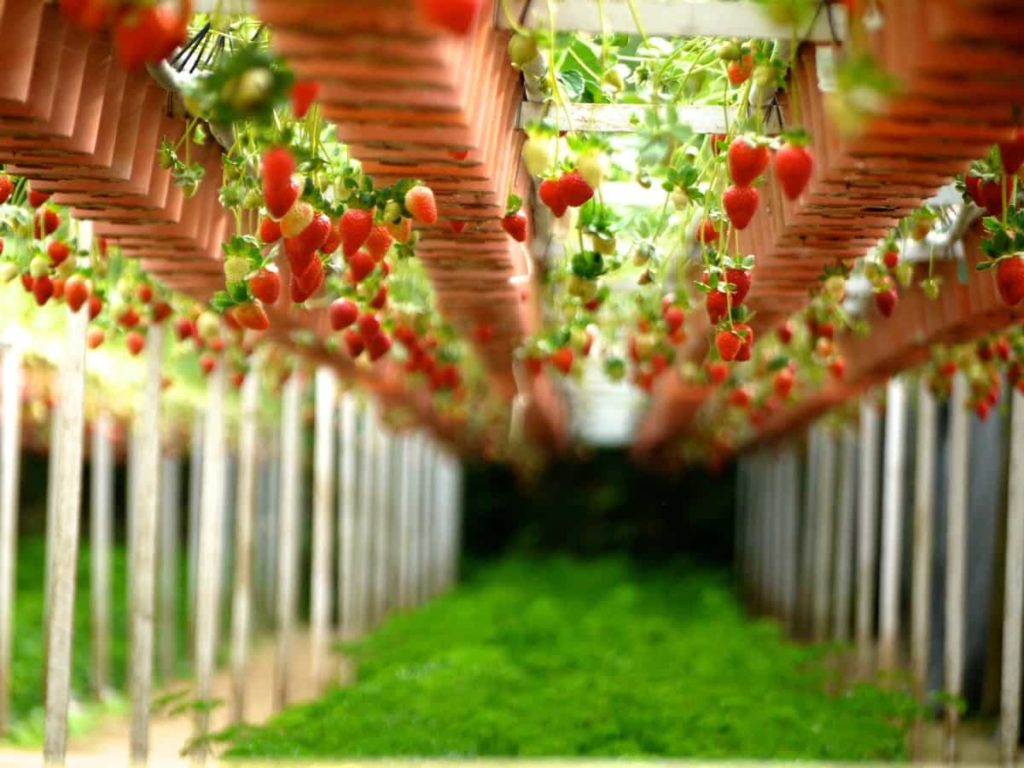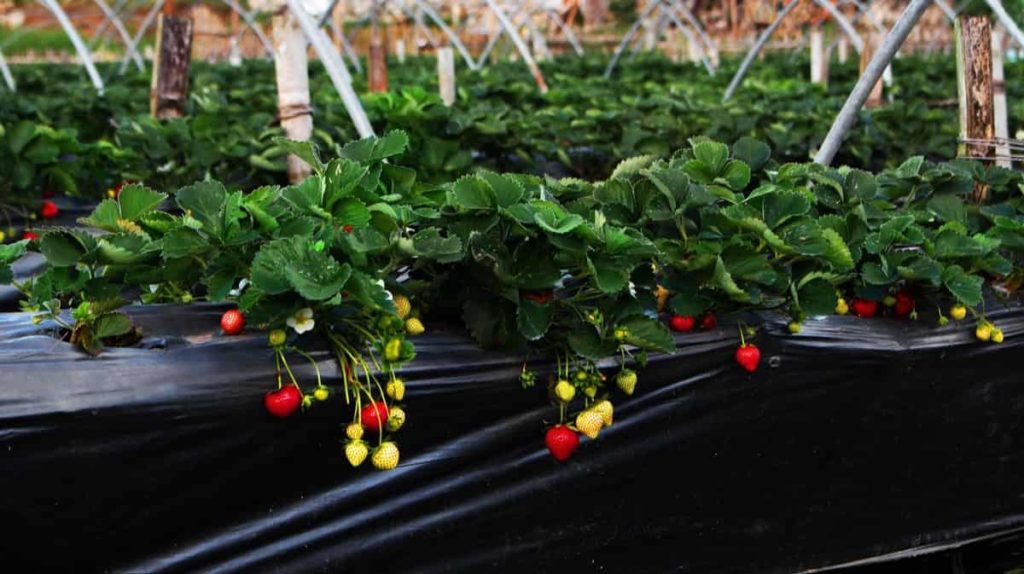Strawberry is an attractive and well-producing plant to grow in your garden. If taken care of carefully, they produce a large number of berries. Sometimes, however, gardeners and farmers have to deal with the problems of their Strawberry plants. The main problems growing Strawberry plants are leaf browning, yellowing, plant death, stunted growth, and leggy ness, which can all be determined by the careful use of better light and water, pesticides, or fungicides, and the use of resistant types of Strawberries.

Pests and diseases can affect Strawberry plant fruits, flowers, leaves, roots, and crowns, sometimes causing the entire plant to fall. Many problems are caused by bacteria, fungi, molds, and viruses. Some can be prevented when symptoms are observed, and you cannot treat some of the most serious diseases of Strawberry plants after plants fall on the ground.
20 Common Strawberry Plant Problems
Strawberry plants turn brown
When your Strawberry plant leaves dry up and turns brown, it’s a sign of problems you’ll need to solve. The strongest possibility behind the browning leaves of your Strawberry plant is that your plant is not being watered well.
Solution – Water Strawberry crops early in the morning or in the evening. The early and late hours are colder than high noon, so the water you give your Strawberry will not just evaporate from the heat. If you are growing Strawberry plants indoors, you should give them more regular water and ensure they are not in any area of your home that is very hot or dry.
Strawberry leaves turn yellow and drooping
Strawberry leaves are turning yellow and wilting, and it is a sign of stress due to too much moisture around the roots. Strawberry plants require soil to moisten but drain well. If the roots are permanently in moist soil, it causes the leaves to turn yellow and promote the fungal disease that can cause the Strawberry plant to die. Strawberries require porous, light, friable soil that allows good drainage.
Solution – This is achieved by modifying soil with many organic substances like compost, leaf mold, or well-rotten manure. These materials have a tremendous ability to keep moisture but allow excess water to get away from the roots, which is the best balance for healthy Strawberries.
With well-drained soil amended with compost, the soil with water is moist. Still, the Strawberry plant with saturated and proper pots and containers stands an opportunity to recover from its yellow appearance. However, Strawberry plants that have long been in the soggy soil are likely to develop root rot and thus are rejected to prevent the spread of the disease.
In case you missed it: Hydroponic Strawberry Gardening Techniques, Tips

Strawberry leaves turn red
pH level – Strawberry prefers soil with a neutral pH level, about 7.0. Leaves turn red if the soil’s pH level differs from neutral.
Solution – Be careful when applying soil amendments and check the soil before planting.
Cold temperature – Cold temperatures can cause discoloration if your Strawberry leaves turn red. Red leafy plants will also stop growing during winter due to cold weather.
Solution – Leave the plants alone; their leaves will be green when it’s hot in spring.
Fungal diseases – Fungal diseases can be responsible when the leaves of the Strawberry plant turn red. The problem is a fungal disease if you see purple and red leaves on your Strawberry plant. Red leaves will gradually turn brown, then die.
Solution – If one of your Strawberry plants is affected by fungal disease, the only thing you can do is try to control its spread. You will need to remove and discard any plants showing fungal disease signs. Do not use plants as compost; when you use it, you may risk spreading the disease compost. Fungal diseases are helped along with overly moist environments.
You would ensure that all water is aimed at the plant base so roots can absorb moisture as it soaks. Strawberries can only use water that is accessible by their roots. You will also need to ensure you do not give plants too much water. Just stick your finger in the soil where your Strawberry plants are growing. If the ground is moist or the soil sticks to the skin of your finger, it is still moist, and it is not yet time to rewater your plants.
Lack of phosphorus- Plants need nitrogen, potassium, and phosphorus to thrive. If the soil needs any of these nutrients more, then your plants can show it with the discoloration of their leaves. Red leaves on Strawberry plants point to a specific lack of phosphorus.
Solution – Before adding more phosphorus to your soil, you must address the red leaves already on your plants. Adding bone meal or phosphorus to your soil can increase the amount of phosphorus present in it. If you are using bone meal, loosen the soil around the edges of the bed where your Strawberry plants are growing and mix in bone meal. Do not keep bone meal too close to your Strawberry plants. Just add it around the edges of your garden bed.
Too much carbon – As carbon increases in soil, microorganisms that break down soil in nutrient plants may need more nitrogen to work. If they don’t get this increase in nitrogen, the carbon doesn’t break down, and your Strawberry plant leaves may turn red.
Solution – Some materials used in gardening high in carbon include pine needles, sawdust, and straw. Use a light hand when applying these ingredients, and stop using them if you suspect that your soil contains too much carbon.
In case you missed it: Growing Strawberries In Greenhouse – Polyhouse

Strawberry plants are not producing
Common reasons are that your Strawberry plants may not be producing the number of berries you like or that they are not growing the way you want them because your plants have experienced a lot of heat or have undergone drought.
Solution – One of the simplest ways to take care of your Strawberries when the weather is hot and dry is to increase their water intake. Increasing the amount of water, you give your plants ensures they become more hydrated, allowing the plant to produce leaves, stems, and berries.
Another reason your Strawberry plants are not producing berries or growing properly is that they have not been pollinated properly. Your Strawberries may be small or distorted if they are not well pollinated. Lack of proper pollination is caused by the rainy season, which causes bees to hide on their roofs and not fly around.
Solution – If you are experiencing a very heavy rainy season and believe that you may not have properly pollinated your Strawberry plants, you have the option to pollinate your plants yourself.
- Leggy Strawberry plants
Strawberry plants are usually bushy and ample, with stems and leaves that spread in all directions.
Solution – If you are dealing with leggy seedlings, it is most definitely due to the growing conditions. To grow strong and hard seedlings, you must ensure they have a healthy amount of light. Strawberries, allow them bright light when they start their lives. When plants grow in low light conditions, they stretch themselves as long as possible to bring themselves closer to light. And to protect energy and resources, they reduce themselves as thin as possible and as much as possible to get closer to light. If you want large and strong plants, they need a lot of light.
The Strawberry is deformed
Deformed berries are often caused by poor pollination. Solution – Bees are the best pollinators of Strawberries, so encourage them to take up residence in their yard. Cold temperatures, rain, and windy weather can slow bee activity, so you can’t get as much pollination as you can if flowers bloom at an inappropriate time.
If necessary, you can hand-pollinate the flowers by dusting each flower with a soft paintbrush, moving from flower to flower, and shifting pollen from the brush. Some insects will cause berry failure with fruit chewing, and even abnormal water during fruit preparation can cause wrong-shaped berries.
Pests
Birds
Birds can be a big problem as your Strawberries start to ripen. When you least expect it, they swoop and snatch all or part of the berry.
Solution – The easiest way to control birds is to cover plants with a lightweight bird net once the berries ripen.
In case you missed it: Best Fertilizers for Strawberries: Homemade, Organic, Compost, Liquid, NPK Ratio, and Schedule

Aphids
These small, soft-bodied insects stick under leaves and trunks, sucking the juice from plants.
Solution – Small attacks rarely cause serious problems, but severe infections can destroy entire crops. Apply suitable pesticides to prevent aphids.
Armyworms
Armyworms are a destructive garden pest that closely groups irregular-shaped holes on plant leaves. If heavy feeding happens, you will have skeleton leaves.
Solution – Methods of organic control work for armyworms such as releasing natural enemies or applying Bacillus thuringiensis.
Japanese beetle
Japanese beetles are easy to find; they are green copper metallic in color. Adult Japanese beetles covered the leaves and damaged flowers. If they are left alone, these insects will cause massive damage to plants.
Solution – Using a floating row cover is a great way to protect your plants from these insects, and if you see adult beetles, you can pick them up from plants and stick them in soapy water. Releasing the parasitic nematodes also reduces the number of Japanese beetles in the soil during winter. If you are struggling with Japanese beetles, consider spraying your plants with neem oil or insecticidal soap.
Loopers
One of the most common insects in Strawberries is the looper. These insects leave large or small holes, causing massive damage. Loopers are green caterpillars with white or cream lines on either side of their body.
Solution – The best way to control looper populations is to encourage and abandon natural enemies in your garden. Gardeners can also hand pick loopers from plants. You can consider applying Bacillus thuringiensis, which will kill the larvae. Avoid using chemical sprays as they eliminate natural and beneficial insects in your garden.
Slugs
These insects cause irregular-shaped holes in plant leaves and stems. Slugs also eat holes in fruit, and slugs might shred the leaves during severe diseases.
Solution-Removing weeds and debris help reduce the slug as it takes their hiding places. At night, slug hand pick from your plants and spread egg shells around the plants to discourage these insects.
Strawberry spider mites
The attack of the spider mite causes yellow leaves and bronze leaves. They may also have webbing-covered leaves; if you look closely, you may see mites moving down the nets or leaves.
Solution – Spraying plants with a strong water jet is a way to reduce the spider mite population in your garden. In addition, insecticidal soaps can reduce the population along with various pesticides.
Thrips
Thrips damage Strawberry plants’ flowers, causing browning anthers and stigmas.
Solution – The thrips appear most in spring on crops Strawberries. Using reflective mulch is a great way to prevent thrips. You can also use appropriate pesticides if you become annoying.
Weevils
Weevils cause notches in your plant leaves and growth and closely bunched leaves. The pest varies from dark to light brown and has white grubs from larvae cream that feed on roots.
Solution – Keeping your Strawberry beds weed-free is an important step to keep weeds out of your garden. Do not plant them too close to blackberry, which has too many weevils. Pesticides that contain pyrethroids are effective in controlling these populations.
In case you missed it: Growing Organic Strawberries On Terrace – In Pots

Diseases
Angular leaf spot
Angular leaf spot causes the formation of small, water-soaked lesions at the lower surface of leaves on your Strawberry plants. Over time, the lesions become larger and deeper green and eventually ooze. This bacterium survives in winter on your crop debris and plants. It survives long on debris but won’t stay in the soil. If you water your plants above, bacteria are spread through water splashing over leaves.
Solution – Unfortunately, getting rid of the Angular leaf spot is difficult, if not impossible. It’s smart to plant certified disease-free stocks and rotate your crops. Using any form of chemical control would be ineffective against this bacterial disease.
Anthracnose
Anthracnose causes round black or light grey lesions on the leaves, but leaves may not die. It also causes dark brown or black, round lesions on the trunks.
Solution – While anthracnose is one of the most common Strawberry diseases, it is also difficult to control. Solarizing soil is one of the best options and weeding plants regularly.
Grey mold
Grey mold is a common fungal disease that causes Strawberry flowers to turn brown and die. It also causes the wrong shape and rotting spots on the fruit. You will find a mass of grey mycelium on the rotting tissue, and eventually, the fruit becomes dry.
Solution – The gray mold emerges after periods of high humidity and moisture. It is impossible to control the weather, although you can control the environment. You must remove and destroy all dead or infected materials and toss any rotten fruits. The application of fungicides is a good move against it, but there is no guarantee that they will work.
Leaf scorch
A fungal disease causes irregular deep purple or brown blotches on upper leaf surfaces. Over time, the leaves scorch, causing large purple-brown spots, and the tissue between the stains can be purple or red. Leaf scorch also lesions on flowers and fruits. This often happens when the leaves are wet for a long time.
Solution – Ensuring that your Strawberry plants have good air circulation and soil drainage is essential. Applying a foliar fungicide can give a lot of control in this situation.
Powdery mildew
Powdery mildew causes spots of the growth of the fuzzy white fungi on the lower leaf surfaces that eventually widen, and you may find purple-red stains on lower leaf surfaces. Your plants cannot produce fruit if powdery mildew handles your plants in severe shape.
Solution – The spores are easily spread by seed and air in winter. You may try to apply protective fungicides to the first symptoms of the disease.
In case you missed it: Hydroponic Strawberry Gardening Techniques, Tips

Conclusion
Strawberries are both tart and sweet with more nutrients. Although their growth is generally easy, gardeners and farmers often face problems such as discoloration, poor growth, or pests. While these problems may seem difficult, they can be solved by simple solutions such as better lighting or water and pesticides, or the application of fungicides.
These solutions will help you to get a high-yielding crop. Strawberries are one of the country’s most grown plants because they have a higher yield-to-effort ratio and can add huge addition to any family garden or commercial crop.
- Cabbage Seed Germination and Selection
- Broccoli Seed Germination and Selection
- Asparagus Seed Germination and Variety Selection
- Seasonal Flower Gardening: Best Practices for Spring, Summer, Fall, and Winter
- How to Grow Hibiscus from Flower
- Plantation Ideas for Home Decoration: A Beginners Guide
- Flower Garden Designs and Layouts for Beginners
- Planting and Spacing Techniques in Papaya: A Beginner’s Guide
- Growing Gold: Essential Techniques for Planting Pineapples
- How to Make Kalanchoe Plant Bushy: Home Remedies and Solutions
- 11 Reasons Why Your Gardenia is Not Blooming: Home Remedies and Solutions
- Eco Elegance: The Guide to Designing a Drought-Tolerant Landscape
- Gardening on a Slope: Strategies for Hillside Landscaping
- Nourish and Flourish: Top Organic Mulches for Thriving House Plants
- Everything You Want to Know about Indian Mogra Flower: Discover Uses and Growing
- Green Thumb Success: Expert Tips for Cultivating Greenhouse Pumpkins All Year Round
- Maximize Growth & Flavor: The Ultimate Guide to Companion Planting in Herb Gardens
- How to Control Rhododendron Problems Naturally: Home Remedies and Organic Ways to Fix Them
- Natural Magic: The Remarkable Benefits of Cinnamon for Plants
- Best Steps to Revive Dying Tulip with Natural and Organic Treatment
- 10 Reasons Why Your Angel Trumpet is Not Blooming: Remedies and Treatment
- How to Fix Periwinkle Leaf and Flower-Related Problems: Natural Remedies and Solutions
- How to Fix Zinnias Leaf and Flower Problems: Discover Natural and Home Remedies
- Organic Steps to Induce Lemon Tree Flowers: A Comprehensive Guide
- Bloom Booster: Crafting the Perfect Homemade Bougainvillea Fertilizer
- Optimizing Growth: A Guide to Applying NPK Fertilizer for Potted Plants
- 10 Best Homemade Fertilizers for Rubber Plant: DIY Recipes and Application Method
- How to Boost Female Pumpkin Flowers: Effective Steps for More Flowers and High Yields
- Transform Your Indoor Garden: Top Benefits of Pink Salt for Houseplants
- 10 Best Homemade Fertilizers for Peacock Plants (Calathea): Easy DIY Guide
- Unlock Blooms: 9 Reasons Why Your Potted Chrysanthemum is Not Blooming
- 8 Reasons Why Your Potted Hibiscus is Not Blooming: Fix it with Simple Solutions
- Unlock Blooms: 9 Key Reasons Your Potted Frangipani Won’t Flower
- 10 Reasons Why Is My Ice Plant Not Blooming: Remedies and Treatment
- 10 Reasons Why My Potted Hydrangea Not Blooming: Treatment and Remedies
- 10 Reasons Why is My Wisteria Not Blooming: Remedies and Treatment